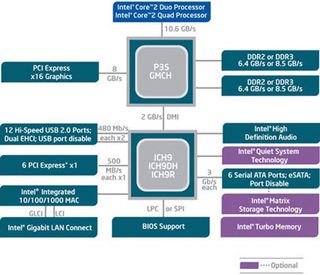Game on with Asus, DFI and Foxconn Mobos
The P35 Express Chipset

If you're looking for a solid platform with decent performance you will most likely consider an Nvidia nForce 650i chipset or Intel's P35. The latter is available on a plethora of different motherboards for less than $100 (although the device can retail for as much as $250). Differences can be found in the feature sets the individual motherboards offer. Features range from on-board cooling solutions to the quality and layout of the components, which determine the overclocking possibilities.
The P35 chipset is based on PCI Express architecture, which is used to connect the Northbridge and the ICH9 Southbridge (2 GB/s Direct Media Interface). The Northbridge offers 16 PCI Express lanes; six more lanes can be found within the ICH9 together with six Serial ATA/300 ports with support for eSATA and Native Command Queuing. Be sure to purchase an optical drive with a SATA interface instead of UltraATA, because the Intel chipset doesn't support UltraATA anymore. Though most enthusiast motherboards offer an additional UltraATA controller to enable the user to connect legacy devices, you will want to disable all unused components.
The 16 PCI Express lanes are typically routed to a single x16 PCI Express slot, which most users use for a dedicated graphics card. Most motherboard companies combine four PCIe lanes of the Southbridge to offer a secondary x16 PCI Express slot running on four lanes. Since the bandwidth is considerably lower (1 GB/s at x4 PCIe vs. 4 GB/s at x16 PCIe), you will not achieve maximum graphics performance when deploying two AMD/ATI Radeon X1000 or HD 2000 graphics cards. The Asus Blitz Formula is capable of splitting the 16 individual lanes into two x16 slots, powered by eight lanes each, which corresponds to what Nvidia offers with the nForce 650i SLI (dual x8 PCIe).
All upper mainstream chipsets come with an integrated Gigabit Ethernet controller, 10 or 12 USB 2.0 ports (ICH9) and a high-definition audio sound system. Please have a look at our Intel 3 series chipset review for more detailed information about this core logic device.
Stay on the Cutting Edge
Join the experts who read Tom's Hardware for the inside track on enthusiast PC tech news — and have for over 25 years. We'll send breaking news and in-depth reviews of CPUs, GPUs, AI, maker hardware and more straight to your inbox.
Current page: The P35 Express Chipset
Prev Page Three Gaming Motherboards With Intel's P35 Chipset Next Page ... And Its CompetitionMost Popular

